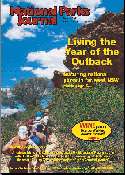
Back to Contents
|
 Editor : Rosemary Pryor |
 Back to Contents |
|
|
Readers
are welcome to respond by letter or e-mail (editor@npansw.org.au)
to other letters or articles in the
National Parks Journal, or to write in about whatever you like. Preference
will be given to short, concise letters. Other letters may be edited or not included,
depending on space limits. |
Who has the power?
I was brought up to enjoy our unique environment and joined the NPA over 20 years ago. Living in the Hunter Valley and working in the electicity industry has always made me aware of the links between electricity generation and the state of our air, water and life in general.
Power stations and the transmission system, being Government-owned, have always operated to meet community expectations of reliability, price and environmental performance because they answer directly to the Minister. In turn, the huge income from the industry supports Treasury in its programs of health and community welfare.
There is now an an active Treasury program to privatise parts of the power system, pretending that these groups — the Advanced Technology Centre (ATC) and Pacific Power (PP) — are somehow unnecessary to its operation. The Government policy of ‘no privatisation’ is being corrupted by subtle re-organisations. These are the very groups that are essential to the efficient operation of generators, and the implementation of new technologies to reduce greenhouse emissions.
The new electricity ‘market rules’ are already adding more CO2 to our skies. If private companies operate the system, including the ATC and PP, they will increase their profits by reducing maintenance and running old, inefficient machines without regular monitoring. Reduced maintenance and monitoring means more emissions, more failures, power shortages and higher prices.
Even though the government has transferred ownership of the existing wind farms and hydro-power sites out of PP, all the technical knowledge and experience to build new schemes and trouble-shoot the existing ones remained behind — and is now for sale.
In just one example in April, staff from the ATC tracked down a problem with a wind generator that the manufacturer and new owners couldn’t identify.
Fred Fetherston
Mayfield, Newcastle
23 April 2002
|
Issue suffers burn-out... It is becoming more and more difficult to understand the NPA’s bias against hazard-reduction as a means of mitigating against large, devastating bushfires. The April issue of the Journal gave prominence to Karen Joynes’ reference to the ‘negative effects of hazard reduction and back burning.’ The Blue Mountains has suffered yet another widespread catastrophe with the recent fires. Populations of insects, small birds and reptiles have been decimated in many parts of the Mountains —for example, on the Patterson Range near Bilpin, it is still difficult to find a single beetle, even now, eight years after the last fire. Hazard-reduction in the Warragamba Catchment was carried out regularly by the Water Board using fire bombs from helicopters until environmental management was taken over by the NPWS and Sydney Catchment Authority in the mid-1990s. Since then, hazard-reduction has been discontinued and the recent wildfire originating in the Warragamba Catchment devastated a tremendous area of bushland. Of course, too-frequent burning of bushland reduces biodiversity — but the present cycle of large-area, frequent wildfires in the Mountains must be stopped before there is no more biodiversity to protect. Strategically-planned hazard reductions carried out in the cooler months in a patchwork fashion could be very effective in stopping the cycle of large, devastating fires. Rick
Jamieson |
It has been brought to the Service's attention that a number of individuals and organised groups may be conducting bushwalks in the artillery impact area of the Budawangs section of Morton National Park, including exploratory walks to find new routes into Clyde Gorge.
NPWS is extremely concerned about the potential risk of injury to walkers and the corresponding potential for exposing others to risk.
Rather than the risk decreasing over time, it actually increases as the unexploded ordnance age...during the recent bushfires, fire operations were restricted over the area due to safety issues and the actual detonation of UXOs that occurred during the fires.
NPWS is preparing a walking and camping safety strategy for the Budawangs that will identify several main tracks suitable for showing on maps, while discouraging promotion of other tracks and routes. The draft strategy will be sent to bushwalking organisations for comment when finalised.
Diane Garrood,
Manager
South Coast Region, NPWS
23 April 2002
|
|
National
Parks Association - Home Page |
|